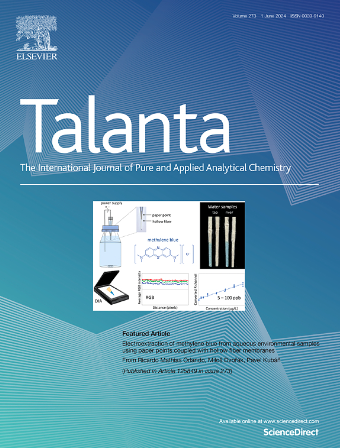基于mof -818纳米酶联体传感器检测食用藻粉中微囊藻毒素lr
IF 5.6
1区 化学
Q1 CHEMISTRY, ANALYTICAL
引用次数: 0
摘要
建立简单、快速、灵敏的微胱氨酸-亮氨酸-精氨酸(MC-LR)检测方法对确保食品安全至关重要。采用金属有机骨架材料MOF-818制备了一种新型纳米酶联比色传感器。适配体和表面带有互补DNA (cDNA)的MOF-818 (MOF-818/cDNA)分别作为生物受体和信号报告者。没有MC-LR, MOF-818/cDNA与适配体结合,催化3,5-二叔丁基儿茶酚(3,5- dtbc)氧化并产生黄色产物。而在MC-LR存在的情况下,它与适配体竞争性结合,抑制MOF-818/cDNA捕获并降低催化活性,从而实现比色定量。方法线性检测范围为1 ~ 200 ng/mL,检出限为0.849 ng/mL。该方法成功地定量测定了掺杂湖水和自来水中MC-LR,以及MC-LR污染的食用藻类(螺旋藻和核核小球藻)粉末中MC-LR的含量,回收率为81.45% ~ 136.67%。本研究为食品和环境样品中MC-LR的筛选提供了一种经济、高效、便携的方法。本文章由计算机程序翻译,如有差异,请以英文原文为准。

A MOF-818-based nanozyme-linked aptasensor for microcystin-LR detection in edible algae powder
The development of simple, rapid, and sensitive detection methods for microcystin-leucine-arginine (MC-LR) is crucial for ensuring food safety. A novel nanozyme-linked colorimetric aptasensor was developed using metal-organic framework (MOF) material MOF-818. The aptamer and MOF-818 with complementary DNA (cDNA) on its surface (MOF-818/cDNA) served as bioreceptors and signal reporters, respectively. Without MC-LR, MOF-818/cDNA bound to the aptamer, catalyzing the oxidation of 3,5-Di-tert-butylcatechol (3,5-DTBC) and producing yellow-colored products. While in the presence of MC-LR, it bound to the aptamers competitively, inhibited MOF-818/cDNA capture and reduced catalytic activity, enabling colorimetric quantification. The method achieved a linear detection range of 1–200 ng/mL and a limit of detection of 0.849 ng/mL. It successfully quantified MC-LR in spiked lake water and tap water, as well as MC-LR-contaminated edible algae (Spirulina platensis and Chlorella pyrenoidosa) powders, with recovery rates ranging from 81.45 % to 136.67 %. This research provided a cost-effective, efficient and portable method for MC-LR screening in food and environmental samples.
求助全文
通过发布文献求助,成功后即可免费获取论文全文。
去求助
来源期刊

Talanta
化学-分析化学
CiteScore
12.30
自引率
4.90%
发文量
861
审稿时长
29 days
期刊介绍:
Talanta provides a forum for the publication of original research papers, short communications, and critical reviews in all branches of pure and applied analytical chemistry. Papers are evaluated based on established guidelines, including the fundamental nature of the study, scientific novelty, substantial improvement or advantage over existing technology or methods, and demonstrated analytical applicability. Original research papers on fundamental studies, and on novel sensor and instrumentation developments, are encouraged. Novel or improved applications in areas such as clinical and biological chemistry, environmental analysis, geochemistry, materials science and engineering, and analytical platforms for omics development are welcome.
Analytical performance of methods should be determined, including interference and matrix effects, and methods should be validated by comparison with a standard method, or analysis of a certified reference material. Simple spiking recoveries may not be sufficient. The developed method should especially comprise information on selectivity, sensitivity, detection limits, accuracy, and reliability. However, applying official validation or robustness studies to a routine method or technique does not necessarily constitute novelty. Proper statistical treatment of the data should be provided. Relevant literature should be cited, including related publications by the authors, and authors should discuss how their proposed methodology compares with previously reported methods.
 求助内容:
求助内容: 应助结果提醒方式:
应助结果提醒方式:


